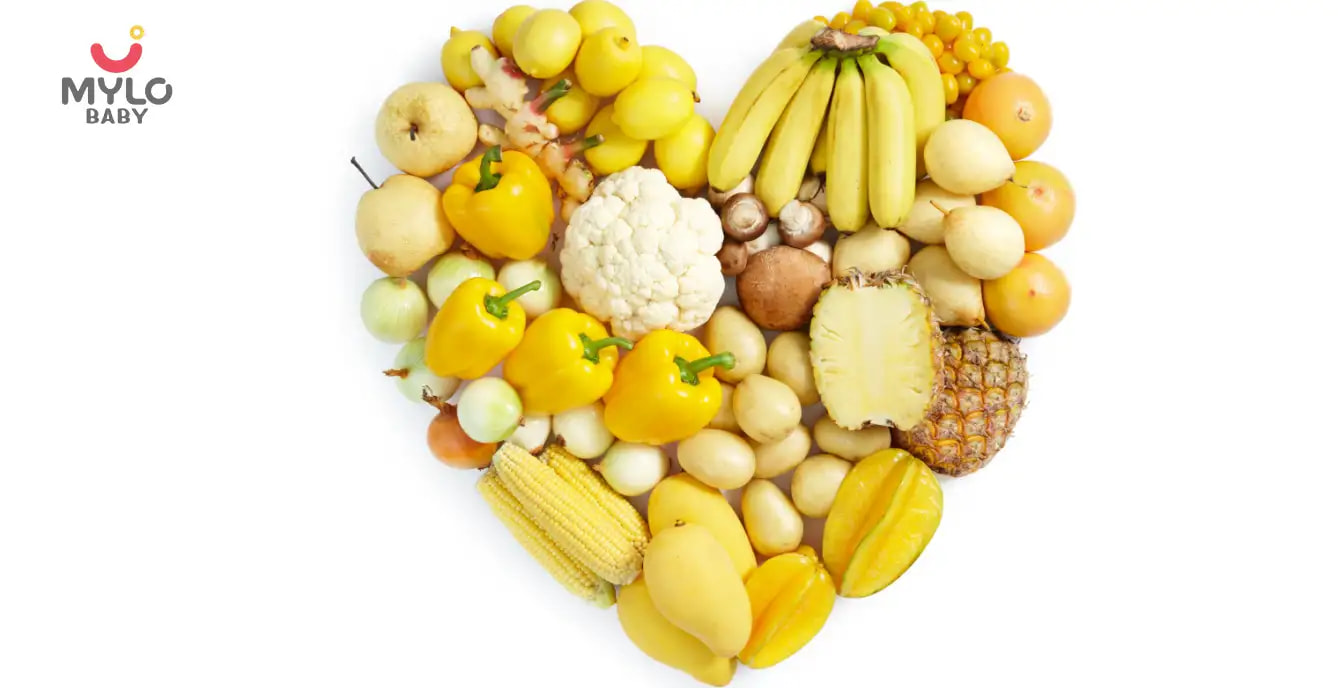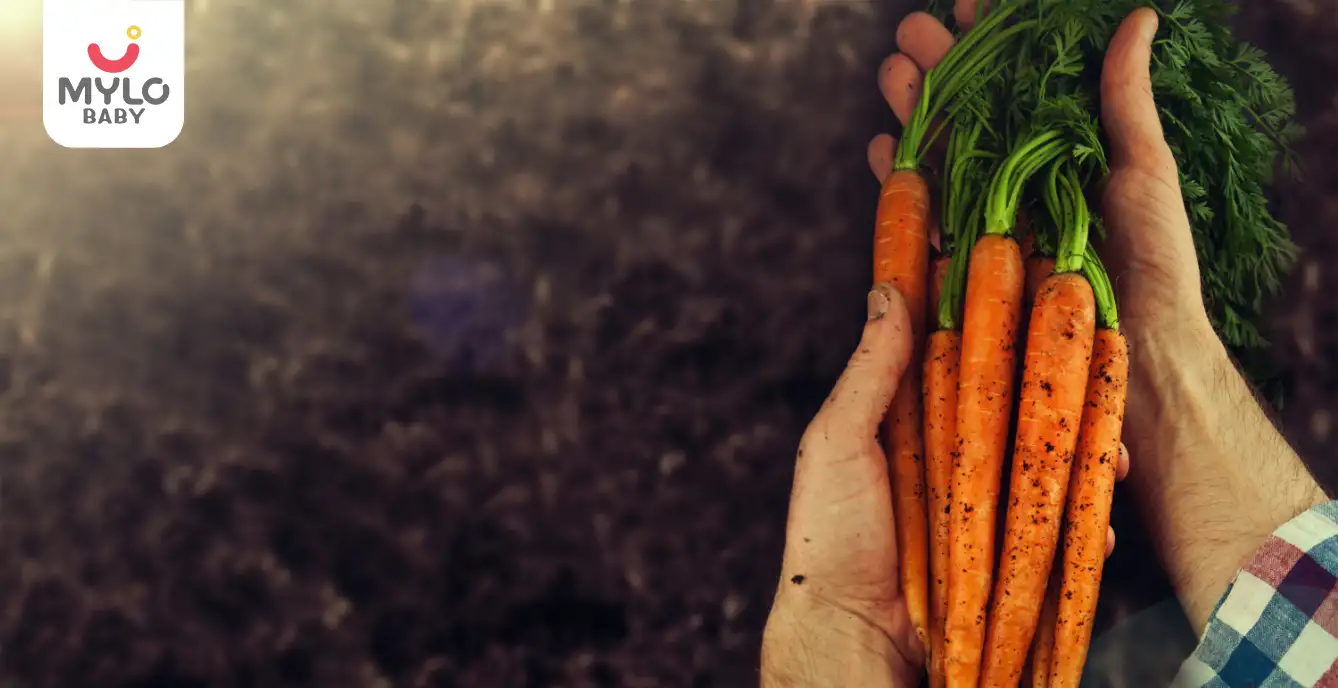Home

The A-Z Guide on Yellow Fruits & Yellow Colour Vegetables for Kids
In this Article

Baby Care
The A-Z Guide on Yellow Fruits & Yellow Colour Vegetables for Kids
Updated on 2 February 2024
As children begin to learn about the vibrant world of fruits and vegetables, introducing them to the diverse spectrum of colors is not only educational but also exciting. In this article, we delve into the sunny world of yellow fruits and yellow colour vegetables. From the zesty lemon to the nutritious yellow bell pepper, this colorful journey will ignite children's curiosity and encourage a lifelong love for wholesome, yellow-hued produce.
What are yellow vegetables?
Yellow vegetables are a vibrant and nutritious addition to any meal. They are packed with essential vitamins and minerals that support the growth and development of children. They get their color from pigments called carotenoids, which also provide them with their many health benefits. These vegetables are not only visually appealing but also offer a wide range of flavors and textures.
These vegetables can be cooked in various ways, such as grilling, roasting, or steaming, to bring out their natural sweetness and enhance their flavors. One of the key benefits of yellow veggies is their high content of beta-carotene, a type of carotenoid that the body converts into vitamin A. Vitamin A is essential for maintaining good vision, healthy skin, and a strong immune system.
You may also like: The A-Z Guide to Identifying Stem Vegetables for Kids
What are yellow fruits?
Yellow colour fruits are not only visually appealing but also bursting with flavor and essential nutrients. They are a great addition to a child's diet as they provide a range of health benefits. They get their vibrant color from pigments called carotenoids, which are also responsible for their many health-promoting properties. These fruits are naturally sweet and can be enjoyed in various ways, making them a delicious and nutritious choice for kids.
These fruits are rich in vitamins, minerals, and antioxidants that support overall health and well-being. Bananas, for example, are an excellent source of potassium, which helps maintain healthy blood pressure levels and supports proper muscle function. Lemons are known for their high vitamin C content, which boosts the immune system and promotes healthy skin.
You may also like: The A-Z Guide to Identifying Winter Vegetables for Kids
Yellow fruits and vegetables
Yellow colour fruits and vegetables offer a wide range of flavors, textures, and health benefits. Let us take a look at some at the names of some of the most popular yellow veggies and fruits:
Yellow fruits name
Here are some yellow colour fruits name along with some interesting facts about each fruit that can help familiarise kids with these fruits:
1. Bananas
Bananas are one of the most popular yellow colour fruits. They are rich in potassium, vitamin C, and dietary fiber, making them a nutritious and convenient snack option for kids.
2. Lemons
Lemons are tangy and refreshing and are high in vitamin C. They can be used to add flavor to dishes, beverages, and desserts.
3. Pineapples
Pineapples are tropical fruits with a sweet and tangy flavor. They are rich in vitamin C, manganese, and bromelain, an enzyme that aids in digestion.
4. Mangoes
Mangoes are juicy and delicious, packed with vitamin C, vitamin A, and dietary fiber. They are a popular ingredient in smoothies, salads, and desserts.
5. Apricots
Apricots are small, orange-yellow fruits that are rich in vitamins A and C. They can be eaten fresh or dried and make a nutritious addition to baked goods and trail mixes.
6. Golden apples
Yellow apples, such as Golden Delicious or Yellow Delicious, are crisp and sweet. They are a good source of vitamin C and dietary fiber.
7. Yellow pears
Yellow pears, such as Bartlett or Golden Russet, are juicy and slightly sweet. They are rich in fiber, vitamin C, and potassium.
8. Yellow plums
Yellow plums are sweet and juicy fruits that are rich in vitamins A and C. They can be eaten fresh or used in jams, jellies, and desserts.
9. Yellow watermelon
Yellow watermelon is a sweeter and milder version of the traditional red watermelon. It is high in vitamins A and C and provides a refreshing treat on hot summer days.
10. Yellow raspberries
Yellow raspberries are a rare and unique variety of raspberries. They are slightly less tart than red raspberries and are a good source of vitamin C and dietary fiber.
Yellow vegetables name
Here are some yellow colour vegetables name along with some interesting facts about each vegetable that can help familiarise kids with these veggies:
1. Sweet corn
Sweet corn is a popular yellow vegetable that is rich in dietary fiber, vitamin C, and magnesium. It can be enjoyed boiled, grilled, or added to salads and soups.
2. Yellow bell peppers
Yellow bell peppers are sweet and crunchy vegetables that are high in vitamin C and vitamin A. They can be eaten raw, roasted, or used in stir-fries and salads.
3. Pumpkin
A versatile vegetable, yellow pumpkin is used in curries, stews, and desserts. It is high in fiber, potassium, and antioxidants.
4. Yellow tomatoes
Yellow tomatoes have a milder and sweeter flavor compared to red tomatoes. They are rich in vitamin C, vitamin A, and lycopene, an antioxidant that may help reduce the risk of certain cancers.
5. Yellow zucchini
Yellow zucchini is a summer squash that is similar in taste and texture to green zucchini. It is low in calories and a good source of vitamin C and dietary fiber.
6. Yellow beans
Yellow beans, also known as wax beans, are tender and slightly sweet. They are high in dietary fiber, vitamin C, and potassium, and can be enjoyed steamed, sautéed, or added to salads.
7. Potatoes
Yellow potatoes, such as Yukon Gold or Yellow Finn, have a buttery and creamy texture. They are a good source of potassium, vitamin C, and dietary fiber, and can be boiled, mashed, or roasted.
8. Yellow onions
Yellow onions have a mild and sweet flavor when cooked. They are a good source of vitamin C, vitamin B6, and dietary fiber, and can be used in a variety of dishes, such as soups, stews, and stir-fries.
9. Yellow beets
Yellow beets are a vibrant and sweet root vegetable. They are high in dietary fiber, folate, and potassium, and can be roasted, steamed, or added to salads.
Tips to make learning yellow color fruits and vegetables easy for kids
Learning about yellow fruits and vegetables can be an exciting and educational experience for kids. Here are seven tips to make the learning process fun and engaging:
1. Make it a treasure hunt
Create a scavenger hunt where kids have to find and identify different yellow fruits and yellow vegetables in the kitchen or at the grocery store. Provide them with a list of items to find and let them explore and discover the vibrant world of yellow produce.
2. Create colorful recipes
Encourage kids to get creative in the kitchen by preparing colorful recipes using yellow colur fruits and veggies. Let them choose a recipe and assist them in gathering the ingredients and following the instructions.
3. Play with food
Turn learning into a playful activity by arranging fruits and vegetables in different patterns or shapes. Encourage kids to create their own artwork using sliced fruits and vegetables as stamps or paintbrushes.
4. Storytime with fruits and veggies
Read books or tell stories that feature yellow fruits name and yellow vegetables name. Engage kids in discussions about the importance of eating a rainbow of fruits and vegetables for good health.
5. Grow your own
Start a small garden or grow potted plants of yellow vegetables like cherry tomatoes or yellow bell peppers. Involve kids in the planting, watering, and caring for the plants.
6. Field trips to farms or farmers' markets
Plan a visit to a local farm or farmers' market where kids can see, touch, and taste different yellow vegetables and fruits. Let them interact with farmers and ask questions about how the produce is grown and harvested.
7. Food tasting parties
Organize a food tasting party where kids can sample various yellow colour fruits and vegetables. Encourage them to describe the taste, texture, and aroma of each item. This sensory exploration will help them develop their palate and discover their preferences.
By incorporating these tips into the learning process, parents can make learning about yellow fruits and vegetables enjoyable and memorable for kids.
Key takeaways
Encourage your child to explore the colorful world of yellow fruits and yellow colour vegetables. Incorporate them into their meals and snacks to ensure they receive a wide range of essential nutrients. Make learning an enjoyable and interactive experience by trying out some of the tips mentioned above. Start by introducing one new yellow fruit or vegetable each week and gradually expand their palate. Your child will not only develop a love for healthy foods but also gain valuable knowledge about the importance of a varied and balanced diet.



Written by
Anupama Chadha
Anupama Chadha, born and raised in Delhi is a content writer who has written extensively for industries such as HR, Healthcare, Finance, Retail and Tech.
Read MoreGet baby's diet chart, and growth tips

Related Articles
Related Questions
Hello frnds..still no pain...doctor said head fix nhi hua hai..bt vagina me pain hai aur back pain bhi... anyone having same issues??

Kon kon c chije aisi hai jo pregnancy mei gas acidity jalan karti hain... Koi btayega plz bcz mujhe aksar khane ke baad hi samagh aata hai ki is chij se gas acidity jalan ho gyi hai. Please share your knowledge

I am 13 week pregnancy. Anyone having Storione-xt tablet. It better to have morning or night ???

Hlo to be moms....i hv a query...in my 9.5 wk i feel body joint pain like in ankle, knee, wrist, shoulder, toes....pain intensity is high...i cnt sleep....what should i do pls help....cn i cosult my doc.

Influenza and boostrix injection kisiko laga hai kya 8 month pregnancy me and q lagta hai ye plz reply me

Related Topics
RECENTLY PUBLISHED ARTICLES
our most recent articles

Women Specific Issues
Cervical Cancer: Causes, Symptoms & Prevention

Education
The A-Z Guide to Identifying Stem Vegetables for Kids

Fetal Heartbeat
Can Fetal Heartbeat Disappear and Reappear?

Education
The Ultimate Guide to Teaching Children 20 to 30 Tables

Education
GK Questions for Kids from Nursery to Class 6

Growth & Development
Height and Weight Chart for Boys and Girls in India
- The A-Z Guide to Identifying Winter Vegetables for Kids
- Dalia in Pregnancy: A Superfood for the Health of Both Mom and Baby
- 1st Birthday Wishes for Your Little One's Big Day
- The Ultimate Guide to Consuming Litchi During Pregnancy
- Almonds in Pregnancy: Cracking the Nutty Secret to Their Benefits
- Popping the Question: Is It Safe to Indulge in Popcorn in Pregnancy?
- Cherry Fruit in Pregnancy: What Every Expectant Mother Should Know
- The Ultimate Guide to Consuming Pista During Pregnancy
- Sugarcane Juice in Pregnancy: Benefits & Precautions
- The Ultimate Guide to Consuming Mushroom in Pregnancy
- The Ultimate Compilation of GK Questions and Their Answers
- The Ultimate Compilation of 2 Letter Words for Children
- The A-Z Guide to Identifying Root Vegetables Names for Kids
- 11 to 20 Table: A Complete Overview for Children


AWARDS AND RECOGNITION

Mylo wins Forbes D2C Disruptor award

Mylo wins The Economic Times Promising Brands 2022
AS SEEN IN
















- Mylo Care: Effective and science-backed personal care and wellness solutions for a joyful you.
- Mylo Baby: Science-backed, gentle and effective personal care & hygiene range for your little one.
- Mylo Community: Trusted and empathetic community of 10mn+ parents and experts.
Product Categories
baby carrier | baby soap | baby wipes | stretch marks cream | baby cream | baby shampoo | baby massage oil | baby hair oil | stretch marks oil | baby body wash | baby powder | baby lotion | diaper rash cream | newborn diapers | teether | baby kajal | baby diapers | cloth diapers |








